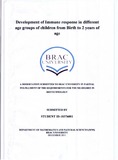| dc.contributor.advisor | Qadri, Dr. Firdausi | |
| dc.contributor.advisor | Choudhury, Prof. Naiyyum | |
| dc.contributor.author | Nowshaba, Nowrin | |
| dc.date.accessioned | 2012-03-14T06:17:56Z | |
| dc.date.available | 2012-03-14T06:17:56Z | |
| dc.date.copyright | 2011 | |
| dc.date.issued | 2011-12 | |
| dc.identifier.other | ID 10376001 | |
| dc.identifier.uri | http://hdl.handle.net/10361/1667 | |
| dc.description | This thesis report is submitted in partial fulfillment of the requirement for the degree of Masters of Science in Biotechnology, 2011 | |
| dc.description | Cataloged from PDF version of thesis report. | |
| dc.description | Includes bibliographical references (page 69-91). | |
| dc.description.abstract | Human neonates are markedly more susceptible to infection than are older children or
adults. This increased susceptibility is generally believed to be due to immaturity of the
immune system to combat pathogens in both quantitative and qualitative terms.
Therefore, it is important to understand the pattern of immune response present at early
age in children. This study was conducted to observe the development of the immune
system in newborns and infants of different ages. For this purpose, 50 participants were
selected and divided into five groups as newborns, 6, 12 , 18 and 24 months of age (for
each group, the sample size was n=10). The T cell proliferation response to tetanus toxoid (TT) was considerably low in newborns than in children of other age groups whereas differences in PHA response were not significantly different. The distribution of T-cell and B-cell specific surface proteins clusters of differentiation (CD) markers on
lymphocytes of participant newborns and infants were analyzed, The percentage of CD3+ T cells were significantly less in newborns than in children 6 months (P< 0.0001), l2 months (P< 0.0001),18 months (P= 0.001) and 24 months (P< 0.0001) old children
while age-dependent gradual decrease was seen in % of CD3+CD4+ (T helper cells) and % of CD3+CD8+ (cytotoxic T cells) and their ratio (CD4+/CD8+) where % of CD 19+ B cells were much elevated in older age groups than in newborns. Cholera toxin (CT) of
Vibrio cholerae specific plasma IgA response was found notably low in newborns than in 6 months (P= 0.0003), 12 months (P= 0.0001), 18 months (P= 0.0001), and 24 months (P= 0.0001) aged children. When compared with 6 month old infants with those that were 12 months (P= 0.02), 18 months (P= 0.029), and 24 months of age (P= 0.007) the CT- IgG response was elevated in 24 months children than newborns (P< 0.0001) and 6 months infants (P= 0.03). Similarly the IgA and IgG response was seen against the heat labile toxin (LT) of Escherichia coll. Significantly high tetanus toxoid (TT) specific IgG response was seen in newborns than in those 6 months (P= 0.04), 12 months (P= 0.02), 18 months (P= 0.007) and 24 months (P= 0.02) of age. In contrast, measles virus specific IgG was distinctly high in 6 months (P= 0.001), 12 months (P= 0.03), 18 months (P=0.009) and 24 months (P= 0.015) old children when compared to newborns using cord blood analyses. A base line level vibriocidal antibody response was observed in the study children. The fecal IgA response was comparable among the infant' groups where heat-labile toxin (LT) fecal IgA was found to be lower in the 6 and 18 months old children, although it was significantly elevated in those 12 and 24 months old children (P= 0.021). This study demonstrated that the maturation of the immune system is mirrored in cellular and humoral immune responses to specific antigens and minimizes the developmental limitations with growing age during infancy. | en_US |
| dc.description.statementofresponsibility | Nowrin Nowshaba | |
| dc.format.extent | 91 pages | |
| dc.language.iso | en | en_US |
| dc.publisher | BRAC University | en_US |
| dc.rights | BRAC University thesis are protected by copyright. They may be viewed from this source for any purpose, but reproduction or distribution in any format is prohibited without written permission. | |
| dc.subject | Biotechnology | |
| dc.title | Development of Immune response in different age groups of children from Birth to 2 years of age | en_US |
| dc.type | Thesis | en_US |
| dc.contributor.department | Department of Mathematical and Natural Science, BRAC University | |
| dc.description.degree | M. Biotechnology | |

